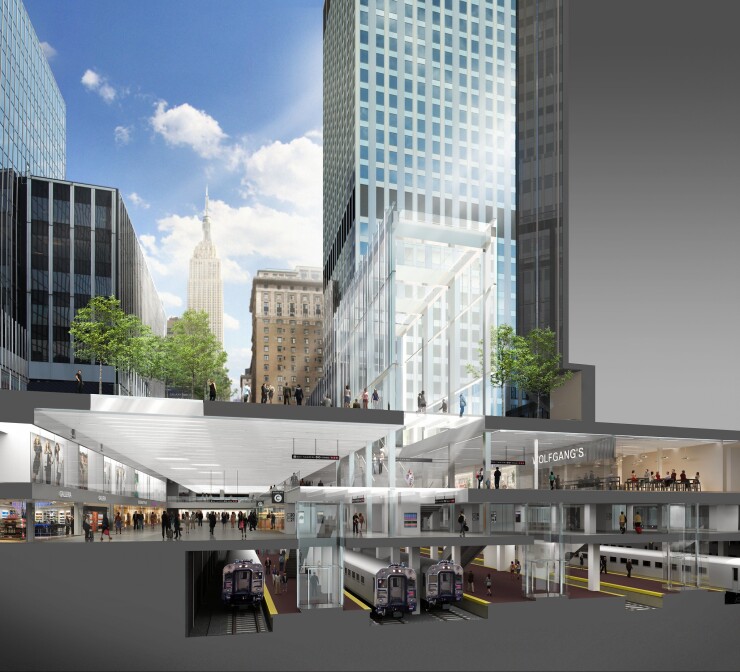A late amendment to New York State’s just-passed $212 billion
While the move prohibits Gov. Andrew Cuomo from using the funds for his “15 Penn” 10-skyscraper plan surrounding the Midtown train station, with politically connected Vornado Realty Trust running point, the battle over the estimated $200 billion project is far from over.
Lawmakers passed the budget bill on Wednesday. Cuomo said he would sign it.
15 Penn Plaza — hence the monicker for the project — would be the anchor high-rise for the new project, comparable in height to the Empire State Building. It would sit at the site of the multi-iteration Hotel Pennsylvania, which Vornado owns, across Seventh Avenue from Penn Station.
Vornado chairman Stephen Roth has donated to Cuomo’s campaigns.
In a rendering book, Vornado called Penn 15 “a super-tall tower that will become the new standard for office design in New York City.”

Cuomo announced the plan in his January 2020 State of the State address.
"The Empire Station Complex project represents the next great investment in our efforts to rebuild and expand this crucial piece of our state's infrastructure and will support economic growth in New York City and across the entire state," he said at the time.
According to good-government organization Reinvent Albany, other sources of state-authorized funding could be available for high-rise developers. “For example, the governor’s past announcements said that value capture with PILOTs could be used,” the organization said, referencing a payment-in-lieu-of-taxes structure.
Reinvent Albany has criticized the secrecy surrounding the project.
“We are also concerned because this very complex megaproject is being handled by multiple government and private sector entities,” it said, citing quasi-public Amtrak and state authorities including the Empire State Development Corp. and the Metropolitan Transportation Authority, not all of whose funds go through the state budget process.
“This makes it difficult for city government, state elected representatives and the public to follow the money and track the planning, overall costs and potential return on investment.”
The train station itself sits under Madison Square Garden with the Moynihan Train Hall, which opened Jan. 1, connecting westward to new space at the site of the former James A. Farley post office building.
On Wednesday, the Empire Coalition, which includes ReThinkNYC, Tri-State Transportation Campaign and the City Club of New York, held a press conference at the station, whose current form took hold in the 1960s after the razing of the old Pennsylvania Station to make room for the fourth version of the Garden.
“The current proposal doubles down on the same outdated approach that’s been obsolete for the last 60 years,” said Barry Caro, a senior advisor for ReThinkNYC, which advocates using Penn Station for through running commuter rail. “We don’t need to build another Penn Station next to the one that already exists. We just need to fix Penn Station.”
The station serves through-running Amtrak trains along the Northeast Corridor, but is an end point for NJTransit and the MTA’s Long Island Rail Road trains. Metro-North service to Penn Station will begin after completion of the East River tunnel rehabilitation and the MTA's East Side Access Project, which will provide direct LIRR service to Grand Central Terminal, making slots available at Penn for Metro-North trains.
In a
Several lawmakers, including U.S. representatives Jerrold Nadler and Carolyn Maloney, both New York Democrats, wrote Cuomo separately to seek a delay.
Others signers included state Sen. Brad Hoylman, whose district includes Penn Station; Manhattan Borough President Gale Brewer; and New York City Council President Corey Johnson.
MTA Chairman Patrick Foye called the project a boon for the LIRR.
“The Penn Station-Empire Complex plan would expand capacity at Penn Station in a meaningful way,” he said. "That, together with for instance the completion of [LIRR] third-track and the opening of East Side access ... frankly, each of them are transformative events for Long Island Rail Road."
Moody's Investors Service last week revised its outlook on the MTA's Triborough Bridge & Tunnel Authority bonds to stable from negative, matching its move days earlier on the authority's primary transportation bond credit.





